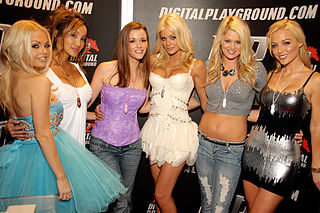
Heterosexuality is romantic attraction, sexual attraction or sexual behavior between people of the opposite sex. As a sexual orientation, heterosexuality is "an enduring pattern of emotional, romantic, and/or sexual attractions" to people of the opposite sex; it "also refers to a person's sense of identity based on those attractions, related behaviors, and membership in a community of others who share those attractions." Someone who is heterosexual is commonly referred to as straight.

A lesbian is a homosexual woman or girl. The word is also used for women in relation to their sexual identity or sexual behavior, regardless of sexual orientation, or as an adjective to characterize or associate nouns with female homosexuality or same-sex attraction. The concept of "lesbian" to differentiate women with a shared sexual orientation evolved in the 20th century. Throughout history, women have not had the same freedom or independence as men to pursue homosexual relationships, but neither have they met the same harsh punishment as gay men in some societies. Instead, lesbian relationships have often been regarded as harmless, unless a participant attempts to assert privileges traditionally enjoyed by men. As a result, little in history was documented to give an accurate description of how female homosexuality was expressed. When early sexologists in the late 19th century began to categorize and describe homosexual behavior, hampered by a lack of knowledge about homosexuality or women's sexuality, they distinguished lesbians as women who did not adhere to female gender roles. They classified them as mentally ill—a designation which has been reversed since the late 20th century in the global scientific community.

Sexuality and gender identity-based cultures are subcultures and communities composed of people who have shared experiences, backgrounds, or interests due to common sexual or gender identities. Among the first to argue that members of sexual minorities can also constitute cultural minorities were Adolf Brand, Magnus Hirschfeld, and Leontine Sagan in Germany. These pioneers were later followed by the Mattachine Society and the Daughters of Bilitis in the United States.

Heteroflexibility is a form of a sexual orientation or situational sexual behavior characterized by minimal homosexual activity in an otherwise primarily heterosexual orientation, which may or may not distinguish it from bisexuality. It has been characterized as "mostly straight". Although sometimes equated with bi-curiosity to describe a broad continuum of sexual orientation between heterosexuality and bisexuality, other authors distinguish heteroflexibility as lacking the "wish to experiment with ... sexuality" implied by the bi-curious label. The corresponding situation in which homosexual activity predominates has also been described, termed homoflexibility.

Lesbian erotica deals with depictions in the visual arts of lesbianism, which is the expression of female-on-female sexuality. Lesbianism has been a theme in erotic art since at least the time of ancient Rome, and many regard depictions of lesbianism to be erotic.

LGBT stereotypes are stereotypes about lesbian, gay, bisexual and transgender (LGBT) people are based on their sexual orientations, gender identities, or gender expressions. Stereotypical perceptions may be acquired through interactions with parents, teachers, peers and mass media, or, more generally, through a lack of firsthand familiarity, resulting in an increased reliance on generalizations.

Homosexuality is a sexual attraction, romantic attraction, or sexual behavior between members of the same sex or gender. As a sexual orientation, homosexuality is "an enduring pattern of emotional, romantic, and/or sexual attractions" exclusively to people of the same sex or gender. It "also refers to a person's sense of identity based on those attractions, related behaviors, and membership in a community of others who share those attractions."

Bisexual erasure, also called bisexual invisibility, is the tendency to ignore, remove, falsify, or re-explain evidence of bisexuality in history, academia, the news media, and other primary sources.

Bisexual pornography is a genre of pornography that most typically depicts men and at least one woman who all perform sex acts on each other. A sex scene involving women and one man who all perform sex acts on each other is generally not identified or labeled as bisexual.

Le Ménage moderne du Madame Butterfly is a bisexual, hardcore pornographic film from France. It is notable for being the earliest known adult film to incorporate bisexual and homosexual intercourse.

A pornographic film actor or actress, pornographic performer, adult entertainer, or porn star is a person who performs sex acts on video that is usually characterized as a pornographic movie. Such videos tend to be made in a number of distinct pornographic subgenres and attempt to present a sexual fantasy; the actors selected for a particular role are primarily selected on their ability to create or fit that fantasy. Pornographic videos are characterized as either softcore, which does not contain depictions of sexual penetration or extreme fetishism, and hardcore, which can contain depictions of penetration or extreme fetishism, or both. The genres and sexual intensity of videos is mainly determined by demand. Depending on the genre of the film, the on-screen appearance, age, and physical features of the actors and their ability to create the sexual mood of the video is of critical importance. Most actors specialize in certain genres, such as straight, bisexual, gay, lesbian, bondage, strap-on, anal, double penetration, semen swallowing, teenage, orgy, age roleplay, fauxcest, interracial or MILFs and more.
A mixed-orientation marriage is a marriage between partners of differing sexual orientations. The broader term is mixed-orientation relationship, sometimes shortened to MOR or MORE.

Gay pornography is the representation of sexual activity between males. Its primary goal is sexual arousal in its audience. Softcore gay pornography also exists; which at one time constituted the genre, and may be produced as beefcake pornography directed toward heterosexual female, homosexual male and bisexual audiences of any gender.

Shifting Gears: A Bisexual Transmission is a controversial GayVN Award winning bisexual pornographic film written and directed by Chi Chi LaRue and released by Channel 1 Releasing in 2008.

Sex in film, the presentation of aspects of sexuality in film, specially human sexuality, has been controversial since the development of the medium. Films which display or suggest sexual behavior have been criticized by religious groups or have been banned or censored by governments, although attitudes have changed much along the years and a more permissive social environment has developed in certain parts of the world, notably in Europe, North America, Australia and New Zealand. In countries with a film rating system, films which contain explicit sex scenes typically receive a restricted classification. Nudity in film may be regarded as sexual or as non-sexual.

Men.com is a producer of gay internet pornography content. It is owned by Aylo.
Johnny Rapid is an American gay pornographic film actor.
Straightwashing is portraying LGB or otherwise queer characters in fiction as heterosexual (straight), making LGB people appear heterosexual, or altering information about historical figures to make their representation comply with heteronormativity.
WhyNotBi.com is a producer of bisexual internet pornography content oriented towards bisexual men. It is owned by Aylo.













